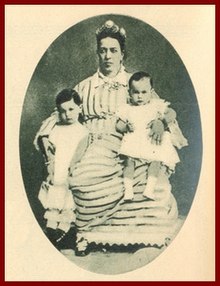Shafaq Nur Hanim
| Shafaq Nur Hanimefendi | |||||
|---|---|---|---|---|---|
| Fourth Princess of Egypt | |||||
 | |||||
| Second Hanimefendi of Egypt | |||||
| Tenure | 15 November 1852 - 1866 | ||||
| Fourth Princess of Egypt | |||||
| Tenure | 1866 - 26 June 1879 | ||||
| Walida Pasha of Egypt | |||||
| Tenure | 26 June 1879 - 17 March 1884 | ||||
| Born | c.1833 Constantinople | ||||
| Died | 17 March 1884 (age:51) | ||||
| Burial | |||||
| Spouse | Isma'il Pasha | ||||
| Issue | Tewfik Pasha | ||||
| |||||
| House | House of Muhammad Ali (by marriage) | ||||
| Religion | Orthodox Christian at birth, converted to Islam after her capture | ||||
Shafaq Nur Hanimefendi (Arabic: شفق نور هانم افندى)(Turkish: Şefeknur Hanımefendi) was the fourth wife of Khedive Isma'il Pasha and was Walida Pasha to their son Tewfik Pasha, the next Khedive of Egypt and Sudan.
Biography
Shafaq Nur Hanimefendi was born in Constantinople.She was delivered to the harem of the Ottoman Sultan Abdulaziz I as a concubine.However,Abdulaziz gave her as a gift to Isma'il Pasha,the Khedive of Egypt.Shafaq Nur gave birth to Tewfik Pasha in 1852,earning her the title of second hanimefendi,meaning second consort.Sultan Abdulaziz ordered Isma'il Pasha to legally marry Shafaq Nur in order to strengthen the ties between the Ottoman Empire and Egypt.The Khedive agreed and he legally married her in 1866, elevating her to the position of the Fourth Princess.[1] Ismail wad deposed by the Sultan of Turkey acting on the advice of the European powers, 26 June 1879, and his son became the Khedive and Shafaq Nur became the Walida Pasha. Shafak Nur exerted considerable influence on him emerging as his staunch defender as the royal family split on the 'Urabi revolution. Alexander Meyrick Broadley, the British lawyer who defender general 'Urabi, described the way she subjected the princesses of the royal family who supported the leader of the revolution to a tongue lashing for their disloyalty and promising to severely punishing them.[2] She died at the Kasr al-'Ali Palace, Cairo, 17 March 1884, and was buried there at the Khedival Mausoleum, Al-Rifa'i Mosque.[3]
Titles and styles
- 15 November 1852 - 1866: Her Honor The second Hanimefendi.
- 1866 - 26 June 1879: Her Highness The fourth Princess;
- 26 June 1879 - 17 March 1884: Her Majesty The Walida Pasha.
References
- ^ Beshara Doumani (February 1, 2012). Family History in the Middle East: Household, Property, and Gender. SUNY Press. p. 258. ISBN 978-0-791-48707-5.
- ^ Mervat F. Hatem (April 12, 2011). Literature, Gender, and Nation-Building in Nineteenth-Century Egypt: The Life and Works of `A'isha Taymur. Palgrave Macmillan. p. 88. ISBN 978-0-230-11860-7.
- ^ http://www.oocities.org/hazemsakr/royal/ismail.html His Highness Hidiv Ismail Paşa Hidiv of Misir (Egypt), Sudan and Taşoz
External links
- Buyers, Christopher. "The Muhammad 'Ali Dynasty: Genealogy". The Royal Ark. Retrieved 2014-12-16.
- Soszynski, Henry. "Walida". Ancestry.com, Inc. Retrieved 2010-02-27.

